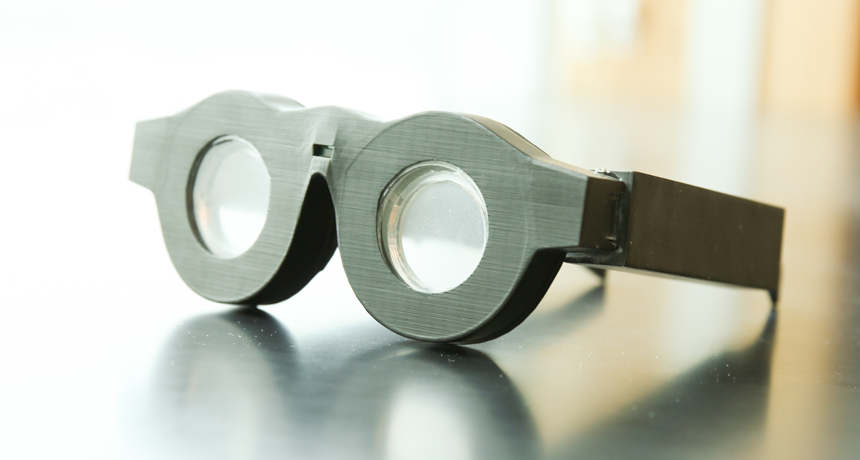Auto-focus eyeglasses rely on liquid lenses
While the prototype may be goofy-looking, you can’t beat its versatility

They're not fashionable, but they're smart. The liquid lenses in these glasses automatically bring your book into focus.
Dan Hixson/University of Utah College of Engineering
With round lenses set in super-thick frames, these new eyeglasses look like they belong on a cartoon character. But what they lack in style, they make up for in smart design. Their lenses are made of glycerin — a thick, colorless liquid — encased in clear rubber. And without effort, they will focus on whatever the wearer looks at.
Nazmul Hasan is the first to admit that the glasses he helped design may not be comfortable — or look cool. “They’re not very fashionable,” he concedes. “And they’re heavy,” notes this graduate student in engineering at the University of Utah in Salt Lake City.
Still, these glasses are truly special. The lenses in normal glasses curve in a specific way to help a person’s eyes focus on something close or far away. Not everyone who needs glasses requires the same curvature. So one person’s glasses will not necessarily work for someone else. In contrast, the glasses that Hasan and his team designed can be adjusted to meet anyone’s visual needs.
Consider, for example, someone who wants to read a Science News for Students story. With an app on her phone, the reader sends her lens prescription to the glasses. Now, when she puts the glasses on, a small infrared (In-fruh-RED) light in the frames begins sending out light pulses. That light bounces off what’s in front of the wearer — here, perhaps your smartphone — and back to the glasses. Those specs use the bounced light to calculate the distance from the glasses to the smartphone screen. Tiny motors in the frame respond by bending the lens so that its curvature matches the person’s prescription. Voila! The article comes into focus.
Tunable, liquid lenses can be turned into “instant prescription eyewear,” says Tracy Xu, who did not work on the new glasses. Xu is an engineer at the University of Central Florida in Orlando. She studies how new technologies that use light — like lasers and lenses — can be used to build devices that help people.
Tunable glasses could be useful in emergencies and in poor countries, she says. A whole family might use one pair as a backup for broken glasses. “Millions of people in developing countries cannot afford an eye exam or do not have access to optometrists,” says Xu. “Low-cost, self-focusing liquid lenses can become a relatively cheap solution.”
Inspired by the student’s advisor — and mom
The new autofocus glasses would be useful to people who need glasses only sometimes — such when they read. Hasan credits the idea for them to the eyewear needs of his advisor at the University of Utah, Carlos Mastrangelo (who also worked on the glasses).
“When he drives, he doesn’t need eyeglasses,” says Hasan. But they’re a must when Mastrangelo reads. Hasan’s mother has the same problem. Many people face such a situation as they get older.
Just behind the cornea — the part of the eye covered with colorful patterns — the eye has a lens. Light rays from the world stream through it and into the eye. For the brain to make sense of the image being looked at, the lens must focus the incoming light. To do that, the lens changes shape. This redirects the light rays.
But over the years, those lenses may not focus so well. People may become nearsighted, which means they can only see things in focus that are close. Or they may be farsighted, which means they only see distant objects in focus. Eyeglasses can correct for these problems. But Hasan points out that for people who suffer many problems, one pair of glasses often won’t do the trick. People might need bifocals, which have two different kinds of lenses, or trifocals, which have three.
That’s where the autofocus glasses can help, he says. When a person like Hasan’s mother reads, the lenses would focus on the words on the page. But when she drives, the lenses would leave the view unchanged. They would adapt to different situations. The prototype, or model, that Hasan and his team have built can switch its focus from on one object to another in just 14 milliseconds. That’s 14 one-thousandths of a second!
Someone who had auto-focus glasses might never have to buy another pair. That’s because any prescription could be uploaded to the frames. Afterward, they would adjust as needed.
But these glasses are not yet ready for the world outside the lab. The lenses only focus in one direction. That’s a problem because people move their eyes around all the time without moving their heads. Hasan says he can fix the problem by installing an eyeball motion detector in the frames. Then the lenses would know what a person was looking at, and adjust as needed.
Today, the frames weigh about three times as much as ordinary eyeglasses. And they’re uglier than anything people would normally wear, Hasan concedes. So his team’s “next aim,” he says, “is to make it more fashionable and lighter.”
This is one in a series presenting news on technology and innovation, made possible with generous support from the Lemelson Foundation.







